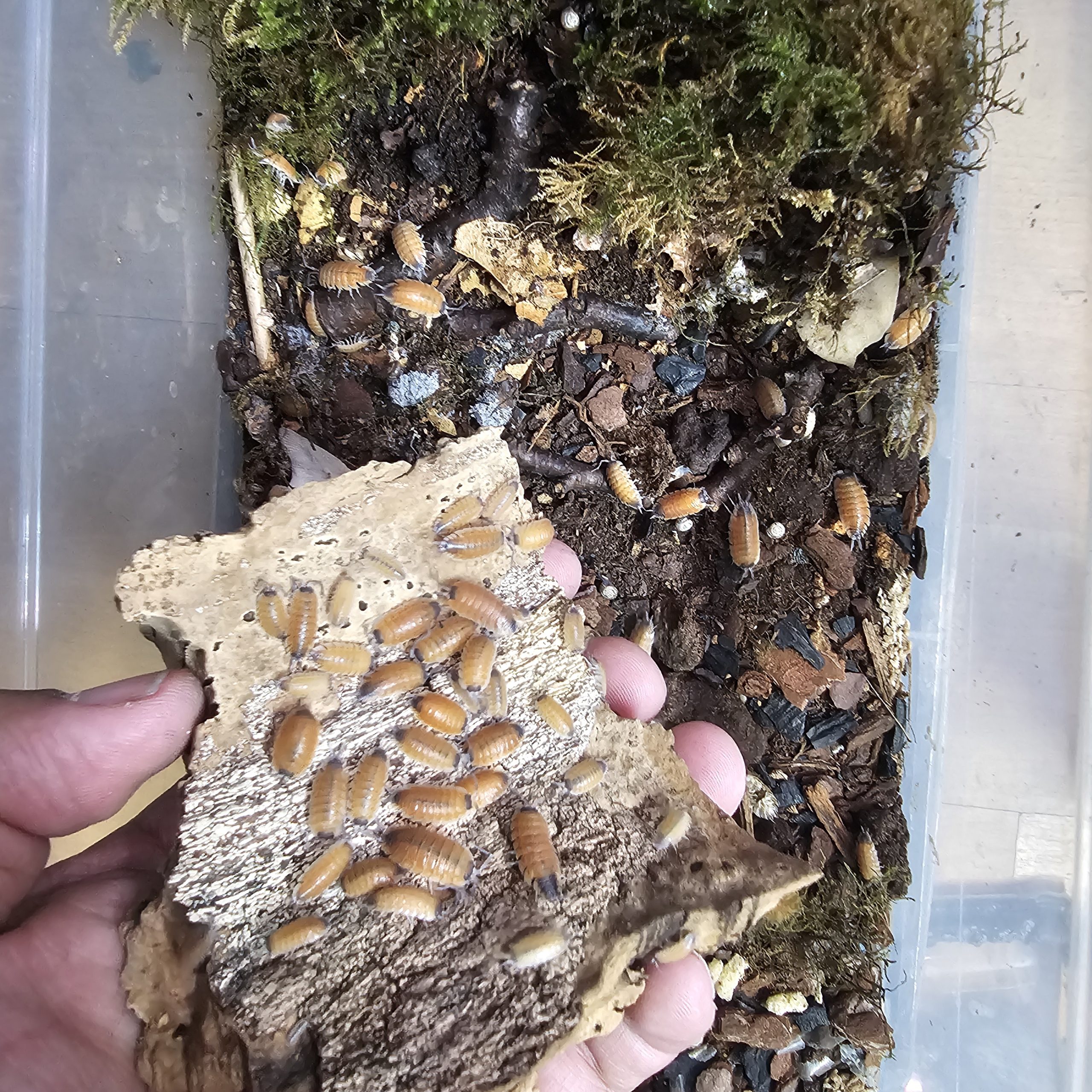If you want your isopods to thrive, reproduce quickly and establish big, stable colonies, their diet matters more than most people realise. Yes, leaf litter and rotten wood form the base of their diet in the wild – but in captivity, closed systems like bioactive terrariums run out of natural nutrition fast. That’s when protein crashes, slow reproduction and even unexplained die-offs begin.
This guide breaks down exactly what to feed isopods to get them breeding consistently – whether you’re keeping dwarf whites for dart frogs, dairy cows and zebras for display tanks or larger Porcellio species like powder oranges and magnificus.
What Do Isopods Eat in the Wild?
In nature, isopods are detritivores. They survive by recycling dead and decaying organic matter. Their natural diet typically includes:
- Decaying leaf litter (oak, beech, magnolia)
- Rotted hardwood (soft, sponge-like wood known as punky wood)
- Fungal hyphae, biofilms and moss
- Animal waste or carcasses (occasional protein boost)
In a forest, this food source is unlimited. In a closed terrarium or box culture, it gets used up. When that happens, isopods begin to slow down, breed less and lose shell strength.
Why Captive Isopods Need More Than Just Leaf Litter
Most keepers start with leaf litter and wood, and while that will keep them alive, it rarely pushes a colony into “explosive growth.” For breeding to really take off, isopods need:
- Calcium – for strong exoskeletons and successful moults
- Protein – fuels reproduction and growth (especially in dwarf whites and powder blues)
- Carbohydrates – main energy source, usually from soft wood and leaves
- Trace minerals & vitamins – improve fertility and offspring survival rates
This is why many breeders now supplement their leaf litter diet with specialist mixes. In our own cultures, we’ve seen faster breeding and fewer failed moults when using a high-calcium isopod diet alongside natural materials.
Essential Nutrients for Isopod Growth and Breeding
To get your colonies breeding fast and consistently, you need more than leaves and a bit of fish food. Below is a breakdown of what they actually need and where to get it from.
1. Calcium – The Foundation of Every M moult
Isopods cannot survive without a constant source of calcium. They reabsorb it before moulting and use it to harden their exoskeletons. Low calcium means:
- Failed moults
- Soft, curled shells
- Death after breeding attempts
Best calcium sources:
- Cuttlebone shavings
- Crushed eggshell (baked, sterilised)
- Calcium carbonate powder (most bioavailable)
- Specialist high-calcium isopod diets
2. Protein – The Key to Reproduction
Protein is a breeding trigger. Without it, isopods will survive, but reproduction slows dramatically. Dwarf Whites and dairy cows especially thrive on extra protein.
Safe protein sources:
- High-quality fish flakes or koi pellets (no added copper)
- Dried shrimp powder
- Bee pollen
- Freeze-dried bloodworms or black soldier fly larvae
- Specialised protein and mineral blends
3. Leaf Litter – Their Natural Staple
Even with supplements, leaf litter is still their main food. Oak, beech, magnolia and guava leaves are ideal. Avoid pine, eucalyptus or chemically treated leaves.
4. Rotten Wood – Biofilm and Carbohydrates
Rotten wood offers carbs, lignin and biofilms. Place chunks of well-decayed hardwood in every culture. They should be soft enough to crumble between two fingers.
5. Moisture & Microhabitats Matter
Even if diet is perfect, poor environment can stop breeding entirely. Make sure you include:
- Moist area with sphagnum moss or damp soil
- Dry zone with leaf litter or cork bark
- Good ventilation to prevent mould, but not so much that it dries out
Foods to Avoid (Very Important)
Not everything labelled “fish food” or “gutload” is safe. Avoid feeding isopods:
- Anything with copper sulfate or copper oxide (toxic to invertebrates)
- Dog/cat food with artificial preservatives
- Mouldy bread or fruit
- Excess fruit – causes mites and overgrowth of fungus gnats
Stick to clean, stable ingredients. This is why many breeders switch to purpose-made blends like a specialist high-calcium breeding diet once colonies begin to expand.
How Often Should You Feed Isopods?
The right feeding schedule depends on colony size, species and enclosure temperature. Too little food will slow breeding. Too much food causes mould, mites and foul smells. As a rule:
- Small starter culture (20–50 isopods): Feed once a week
- Growing colony (100+): Feed twice a week
- Established breeder bin (300+): Light feed every 2–3 days
Always feed small amounts. The food should be mostly gone within 48 hours. If it’s still sitting there, reduce the amount.
✅ Example Weekly Feeding Schedule
| Day | Food | Notes |
|---|---|---|
| Monday | Small pinch of protein + calcium mix | Place on leaf litter or a feeding slate |
| Wednesday | Handful of fresh leaf litter or rotting wood | Keep mossy side moist, dry side dry |
| Friday | Tiny amount of vegetable (courgette, sweet potato, cucumber) | Remove leftovers after 24 hours |
| Sunday | Specialist high-calcium isopod diet | Use a pea-sized amount per 50–100 isopods. We use this one: high-calcium isopod diet. |
Tip: Feeding Slate Method (Prevents Mould)
Instead of placing food directly on soil or moss, put it on a flat surface like:
- A broken piece of slate
- Cut-up plastic bottle lid
- A small tile or feeding dish
This prevents food from sinking into substrate and rotting — it also allows you to easily remove leftovers.
How Much Food Is “Too Much?”
If you see any of these signs, reduce feeding immediately:
- White fuzzy mould on leaves or food
- Explosion of mites or springtails only eating leftovers
- Foul smell (should smell earthy, not sour)
- Condensation building up constantly on lid
Healthy cultures smell like forest soil — damp, leafy and neutral.
How to Encourage Isopods to Reproduce Quickly
Once your colony has a stable environment and constant food source, reproduction should happen naturally. However, to really boost breeding rates, you can intentionally trigger reproductive behaviour by improving nutrition, humidity and hiding spots.
✅ Top Ways to Boost Isopod Breeding
- Keep one side constantly damp — isopod mancae (babies) dehydrate easily
- Provide deep leaf litter — they hide, eat and give birth inside it
- Add rotting wood and sphagnum moss — essential for humidity and biofilm
- Feed a protein and calcium-rich supplement at least once a week
- Keep temperature between 20–24°C — breeding slows below 16°C
We found that once we began using a specialist high-calcium breeding diet, our dwarf white reproduction rates doubled within one month. Females started producing larger broods and failed moults became extremely rare.
🚫 Why Isopods Stop Breeding
If your colony has stopped producing babies, first check for these common issues:
- Environment is too dry — mancae dry out and die immediately
- No calcium source — failed moults, soft shells, reproductive stress
- Not enough protein — especially in fast-breeding dwarf species
- Culture is overcrowded — lack of space or oxygen
- Too much fruit or vegetables — leads to mites and fungus gnats
Optimal Humidity and Temperature
- Humidity: 70–90% in the damp end (must never fully dry out)
- Temperature: 20–24°C ideal (slows drastically under 18°C)
- Ventilation: Always needed to prevent stagnant air and mould
If everything is correct and they’re still slow, try boosting protein for 2 weeks. Small amounts of shrimp powder, bee pollen or a purpose-made protein and calcium blend for isopods works extremely well.
Frequently Asked Questions
What should I feed my isopods?
A balanced diet should include leaf litter, rotting wood, a source of calcium (like cuttlebone or calcium powder) and a small amount of protein. For faster breeding and healthier shells, many keepers now use a specialist high-calcium isopod diet once or twice per week.
How often should I feed isopods?
Most colonies do best when fed 1–2 times a week in small amounts. Large breeding cultures can be fed every 2–3 days. Food should mostly disappear within 48 hours.
Why aren’t my isopods breeding?
Usually due to lack of moisture, low protein, calcium deficiency or temperatures below 18°C. Make sure one side of the enclosure is always damp, provide leaf litter and add calcium/protein-rich foods regularly.
Do isopods need protein?
Yes. Protein is the main driver for reproduction. Without it, isopods survive but breeding slows dramatically. Safe protein sources include fish flakes, shrimp powder, bee pollen and specialist protein diets.
What temperature is best for isopods?
20–24°C is the ideal range for most species. Below 16–17°C, breeding slows or stops completely. Avoid temperatures above 28°C as they may cause die-offs.
Can I overfeed my isopods?
Yes. Overfeeding leads to fungus, mites and bad smells. Only feed an amount that is eaten within 1–2 days. Use a feeding slate or tile to easily remove leftovers.



